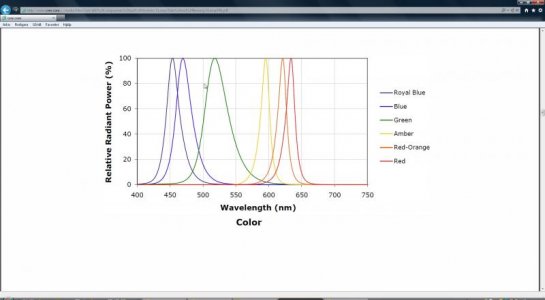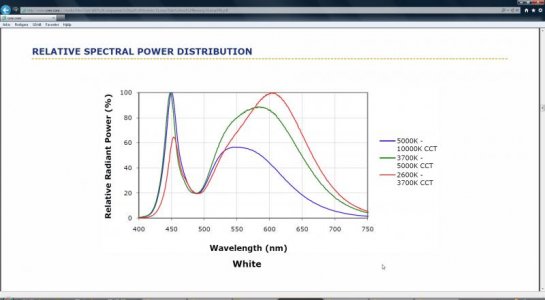UV usually counts below 400 nm (UV-A) in the normal context. 420-430 is violet also called actinic. RB is a floating term first used by Cree and became very famous. Then there came out a lot "RB" in the market. What distinguishes AC-RC from other right now is that he puts out the wavelengths (or K white) - not just only "trade names". Initial RB - Cree - wavelength range you can see below.

RB is far left. You see that the peak is around 460 nm and at 420 nm, only about 25% of the intensity that it gives at 460 still left - eg photons is about 75% less. The area that I think is most important is 420-455, so you should concentrate on these wavelengths. What I wanted to say is that to get as much light at 420 nm compared with Cree RB it’s enough with 1/4 as many watts (Watts is a bad parameter but unfortunately the most useful right now) This means that one must be careful about switching from Cree RB to these wavelengths below 460 nm. You cannot use the experience of Cree's RB to determine the strength of this construction. If you also use 455, 445, 430 and 420, you have to keep in mind that the intensity at 420 nm is much higher than just its own intensity, as the other three also contribute. And of course, vice versa if you look to the intensity at 455 nm. This is the cause why this configuration was chosen for the Dream chip: 20 pcs 455 pcs 20 445, 10 430 and 10 420 If I should take up the wavelength I think is most important as it 445 nm. It and the 430 are the ones that get maximum total intensity of dream chip design.
But back to being cautious when starting the usage of these wavelengths. I want to emphasize once again - be careful - start at a low dose - increase slowly over a few months.
If you take a look at this graph

Datasheets are taken from Cree because I do not have access to the spectra of the white from RC right now - it will.
Here you can see a peak at about 455 (which means that it is the blue LED that is covered with phosphor to get the white light) but if you see the surface of the charts so is the most quantity of light at other wavelengths. It is stronger blue peak higher K. Now different phosphor mixtures from each other so no direct transfer to AC-RC's high Kelvin chip cannot be done, but the blue is less prevalent there.


